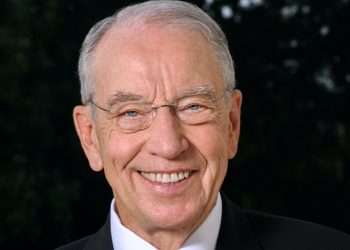DES MOINES, Iowa – Gov. Kim Reynolds, during her press conference on Thursday, announced that the state of Iowa anticipated receiving 172,000 doses of the COVID-19 vaccine before the first of the year.
She said, pending approval, that the state anticipates receiving 26,000 doses of the Pfizer vaccine around December 13, with another 95,000 doses arriving the week of December 27. Also, 54,000 doses of the Moderna vaccine are anticipated for the week of December 20.
“According to the recommendation of the CDC, and in Iowa, we’ll distribute a portion of the allocation to hospitals for their workforce and to our long-term care facilities. The federal government has developed a long term care pharmacy partnership, and that is a program that leverages national pharmacies to help administer the vaccine in long term care facilities. This will allow us to quickly and efficiently vaccine our most vulnerable population first and communities across the state,” Reynolds said.
Kelly Garcia, interim director of the Iowa Department of Public Health, warned, “Life will not return to normal immediately. With this, we do have a sense of a light at the end of the tunnel.”
She said the state is learning new information from their federal partners every day regarding distributing the vaccine.
Two companies – Pfizer and Moderna – have applied for emergency use authorization from the Food and Drug Administration (FDA). The Pfizer vaccine has a 95 percent efficacy against COVID-19, while Moderna has a 94.5 efficacy against the coronavirus. Both vaccines require doses in two stages 21 days apart for the Pfizer vaccine and 28 days apart for the Moderna vaccine.
Garcia said health care professionals, long-term care facility residents, and staff are the first priority, but as more COVID-19 vaccine becomes available, more populations will be added.
“We anticipate that by mid-2021, there should be enough vaccine available for anyone who wants to receive it,” she said.
“We’ll position the first distributions in hospitals and will start to vaccinate health care professionals. But our strongest focus will be on Long Term Care residents and their direct care staff. The CDC is allocating the COVID-19 vaccine to Iowa based on population size and these target populations. We will pre-position a portion of our initial vaccine allocation to healthcare facilities and reserve the remaining initial Pfizer vaccine allocation for the long term care pharmacy partnership,” Garcia added.
The pharmacy partnership program is a federal initiative that will work with Walgreens, CVS Pharmacy, and Community Pharmacy to administer vaccines, free of charge, in long-term care facilities.
“This program ensures vaccine access to the rural parts of our state. As these pharmacies are able to serve any long term care facility within a 75-mile radius of their locations,” Garcia said.
She said the Iowa Department of Public Health would convene an infectious disease advisory council to help develop COVID-19 vaccine prioritization of populations during the early stages of distribution while supply is limited.
“This group will bring together ethical and clinical expertise from across the state to represent multiple perspectives including rural and urban populations, hospital administration, infectious disease specialists, vulnerable populations and congregate settings, advocates for aging populations and individuals with intellectual and developmental disabilities and refugees. The reason for this is to minimize health inequities based on geography, poverty and other social determinants. This group will also provide input as additional vaccines become available and will help us navigate our distribution of therapeutics,” she explained.
Garcia said transparency is key, and she wants to keep Iowans updated on the vaccine’s availability. Still, the state will not release the distribution sites to “ensure the safe distribution of this limited resource.”
She also announced that 112 hospitals in Iowa had received therapeutics to help treat those hospitalized with COVID-19.
“I want to underscore that life will not immediately be back to normal. Please continue all of the necessary mitigation efforts. Please wear a mask, minimize or eliminate gatherings. We have winter months ahead and need to ensure our health care workers remain able to provide the highest level of care to Iowans,” Garcia concluded.
Reynolds also included Dr. Brooks Jackson, Vice President for Medical Affairs for the University of Iowa Hospitals and Clinics, in her press conference. The University of Iowa was involved in the COVID-19 vaccine clinic trials.
“As an investigator of a number of vaccine and drug trials for infectious diseases, I believe Iowans should feel confidence that the COVID-19 vaccines that will become available shortly are effective and safe. Given the efficacy and safety data we have seen to date, the COVID vaccines, like all drugs and medical devices, are going through multiple phases of rigorous testing, analysis, and review as they are developed,” he said.
Brooks said the available safety data and the Carver College of Medicine’s experience are “very reassuring.” He said the vaccine’s side effects are “minor and transparent and acceptable” given its potential benefit.
Reynolds also said her administration is encouraged by the downward trend in statewide positivity and hospitalization rates.
“At the beginning of the month of November, our statewide 14-day average positivity rate was 30.7 percent. The current 14-day average is 16.7 percent, and the current seven-day average is 13.9 percent. At the county level, the 14-day average positivity rates are stable or decreasing in the majority of our 99 counties. Currently, 32 counties have a 14-day average positivity rate above 20 percent, 45 counties are between 15 and 20, 20 counties are between 10 and 15 percent. And only two right now are below 10 percent. So we still have some work to do to bring those rates down,” she stated.
“We’re monitoring all data very closely over the next several days for any indicators of increased activity following the Thanksgiving holiday. And we’re hopeful we can keep the trends moving downward,” Reynolds added.
She also added that 30 long-term-care facilities were coming off the outbreak list this week because they have not had new cases for 28 days.















